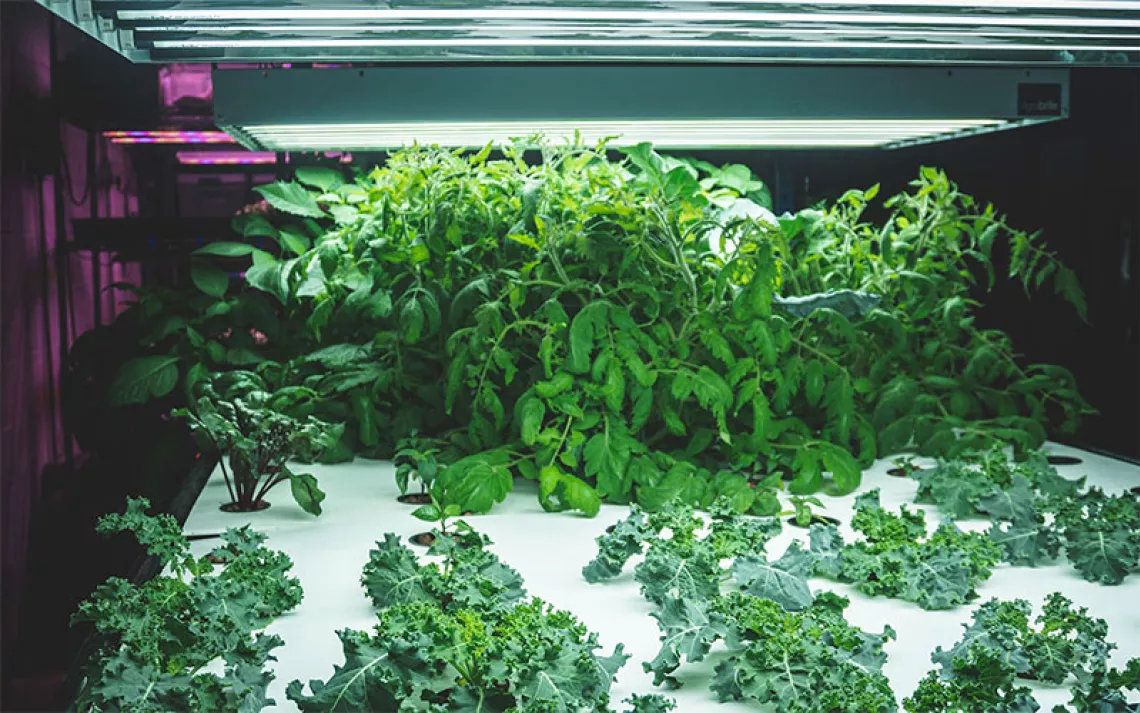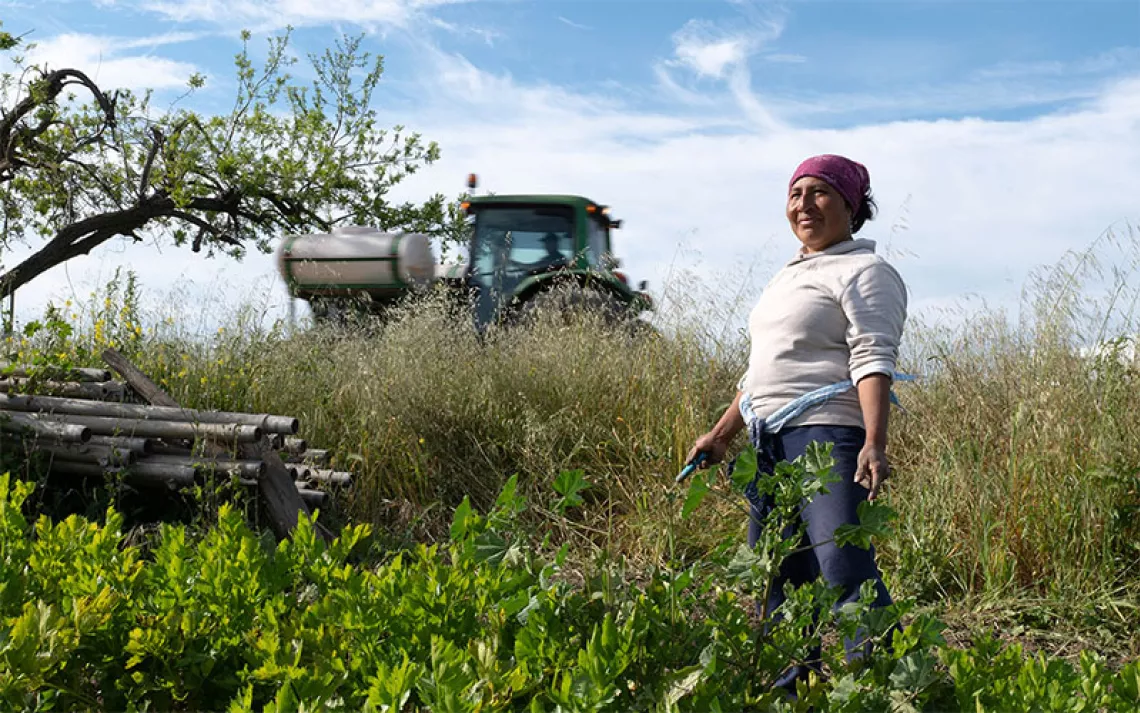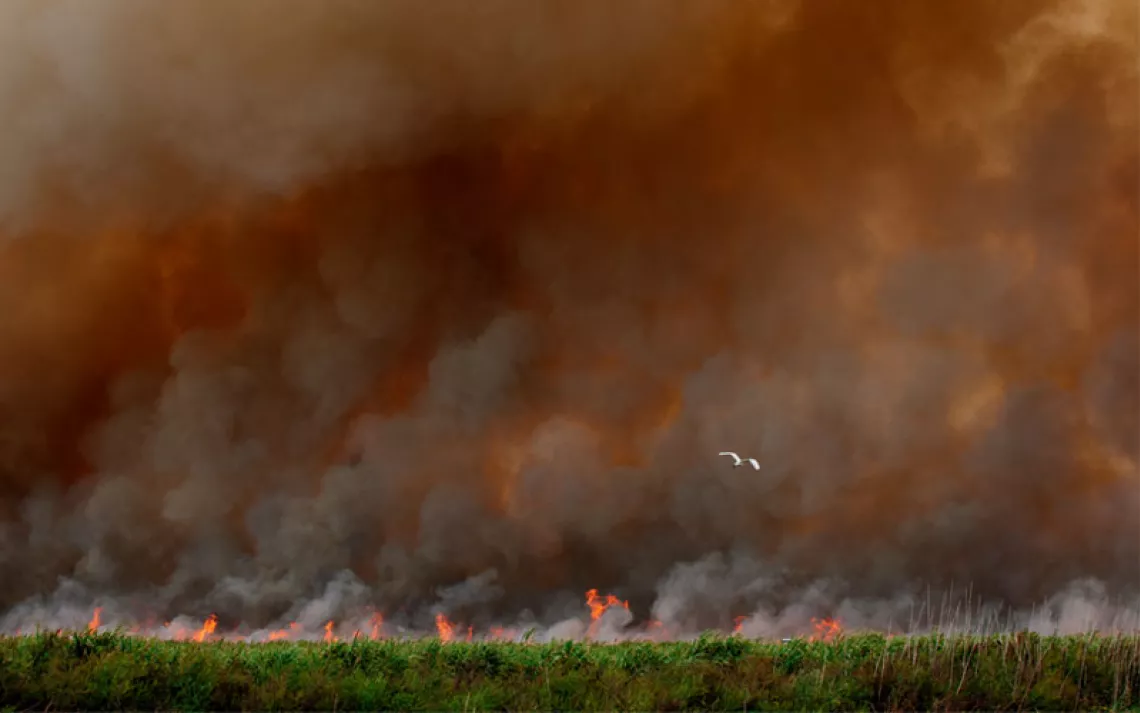Regenerative Farms Look to Keep Plants Healthy and People Fed
Climate mitigation and adaptation meet in a new kind of resilient agriculture

Photo by Sundry Photography/iStock
Ten acres of vegetables sit between the wildfire-scorched foothills of the Santa Cruz Mountains and a winding section of Highway 1 that connects San Francisco to the Monterey Bay. The field is more linear and colorful than the coastal plain that stretches between the hills and the Pacific. A flock of small birds darts between crops, ducking under the spiked leaves of artichokes and between stalks of tall sunflowers.
Cole Mazariegos-Anastassiou is one of three proprietors at Brisa Ranch. We pass a holding reservoir, full despite the drought, and rows of strawberries, peppers, and greens that the water irrigates. We reach the north end of the field where Mazariegos-Anastassiou and his co-owners are growing their first crop in new soil, winter squash. When the big plants die, he says, their broad leaves and thick stems will sink into the earth, providing habitat for the bacteria that will help support the underground ecosystem that keeps their crops healthy.
Brisa Ranch is a regenerative farm, one that uses agricultural practices designed to build soil structure rather than to erode it and that uses ecological functions for farm management rather than inputs like fertilizers and pesticides whenever possible. By planting cover crops in the off-season, not tilling the soil, and growing multiple kinds of crops alongside native plants, regenerative farms both store atmospheric carbon in the soil and create agricultural landscapes more capable of growing food in an increasingly volatile climate. On regenerative farms, carbon removed from the atmosphere creates subterranean habitats that keep plants healthy and people fed.
Ratan Lal, a soil scientist at Ohio State University, estimates that if regenerative methods like no-till farming and cover cropping were implemented globally, they could offset 15 percent of world emissions. Even in this most optimistic scenario, he says that an immediate and aggressive transition away from fossil fuels would still be the only way to avert the worst effects of the climate crisis. But Claire Kremen, who studies diversified farming at the University of British Columbia, says climate mitigation is only one aspect of what makes regenerative farming valuable.
“I know right now everyone is rightly very concerned about climate, but it's one of those very unusual things where we can do a lot of good to a lot of different systems at once,” Kremen said. “The biodiversity system, the water system, the climate system. That multifunctionality makes it more compelling.”
The multiple systems benefits that regenerative farms provide to landscapes are rooted in the techniques that distinguish them from conventional operations, whether they use chemicals or are organic. One hundred miles north of Brisa Ranch, regenerative farmer Paul Kaiser has seen the landscape and ecology of Singing Frogs Farm evolve in response to 13 years of changing agricultural practices. In the early years, he spent hours pulling beetles off his eggplants one at a time and dredged the pond at the low end of the farm to remove soil that had eroded. After he transitioned to a no-till system, and stopped disturbing the soil, he says that many of those problems vanished.
No-till farming, one of Ratan Lal’s main criteria for what he considers a regenerative farm, means planting crops year after year without turning the soil over in between, a process that both kills beneficial bacteria and releases stored carbon into the atmosphere. When kept in the soil, carbon does not contribute to climate change. It also forms soil aggregates, which provide habitat for bacteria and worms, the building blocks of an underground ecology that helps grow healthy plants. After 13 years, Kaiser says he hardly worries about pests, weeds, or erosion, a stark contrast to his first three years of farming with a till-based system.
“The things that changed were, one, we went no-till, and our soil became vastly more robust and healthy with a far greater amount of biological activity to interact with the roots of the plants,” Kaiser said. “The other thing that changed was we began to see the ecology that we had invested in starting on day one had finally grown into its own, and so began supporting the functioning of the farm.”
Another principle of regenerative farming, biodiversity is a drastic departure from monocrop systems, which spread corn, almonds, or strawberries over as many acres as possible. While no-till farming increases belowground biodiversity, growing multiple crops in complex rotations alongside native plants helps bring pollinators and pest-predator insects and birds into the agricultural system. Studies have shown that both intercropping and rotating crops over seasons lead to improved stress resistance in plants, helping them handle the fluctuations of a destabilized climate.
Kaiser uses trees and hedgerows of shrubs to bring more species onto the farm, while Brisa plants 50 varieties of crops and other beneficial plants. Instead of using pesticides on their greens, either chemical or organic, they grow sweet alyssum, which attracts a wasp with an appetite for aphids.
“The agroecological standard is about creating an ecosystem in your farm, and working with what is already there,” says Verónica Mazariegos-Anastassiou, another of Brisa’s owners.
Kaiser has seen biodiversity save his crops. After a March heat wave, a weather event becoming more common with climate change, a swarm of aphids covered the chard he planned on bringing to a farmers' market. Assuming the greens were lost, he moved on to harvest his other crops. When he returned a few days later, the aphids were gone, and the dark green leaves were crawling with ladybugs. The chard crop was 15 feet away from a hedgerow. When the heat wave struck, the aphids woke up first, but predatory ladybugs quickly followed.
Kremen says biodiversity on an agricultural landscape is about more than the variety of crops planted at once, and also includes the number of crops planted in the same place over time. Even in a monoculture system, a cover crop can increase temporal biodiversity, providing different nutrients to the soil and helping attract pollinators and beneficial insects to a farm.
When their vegetables aren’t in the ground, Brisa Ranch plants a cover crop. One of the cornerstone practices of regenerative farming, cover crops continue to sequester carbon even when crops aren't being grown for sale, prevent erosion, and add nutrients to the soil. Cover crops create a more porous soil that's better able to weather drought and absorb water during floods, helping farms deal with rainfall patterns trending toward extremes. One of the species in Brisa’s mix is a dry bean, which adds nitrogen to the soil that other plants can draw on later, avoiding the nitrogen fertilizer that is a common input in conventional farms. Creating chemical fertilizers is an energy-intensive process and part of the reason conventional farms emit more carbon than they sequester. Reducing inputs and relying on ecosystem services for nutrients and pest control means emitting less to grow the same crop.
“If you can reduce the use of fertilizers and pesticides you're already doing climate mitigation,” Kremen said.
Lal believes that regenerative operations are better equipped to feed communities in a less-stable climate. Taken separately, no-till, biodiversity, and cover cropping each contribute to climate mitigation and adaptation. When working together, they make regenerative farms much better equipped to grow food during the extreme weather events that are a symptom of our climate crisis. A growing body of research suggests that regenerative farms have more stable yields than their conventional counterparts. In a good year, Lal says a conventional system will have a higher crop yield than a regenerative farm, but good years are becoming less and less common. In bad years, regenerative farms grow a bigger crop.
“It is really climate smart agriculture,” Lal said.
Kremen points to two examples in the last decade that demonstrate this trend. In 2012, a drought struck the midwestern United States. While conventional farms took heavy losses, she says, farms incorporating regenerative practices like cover crops still came away with a healthy harvest. A continent away, during a long dry period in the Cesar River Valley in Colombia, thin cows ate dry grass on conventional farms, while their neighbors had plenty to eat in a silvopastoral system, incorporating both trees and perennial bushes.
Brisa Ranch is weathering its own drought, but Cole, Verónica, and their partner Cristóbal Hernández are not concerned. They planted based on their available rainwater and know they have enough to get by. The trio have only been farming at Brisa for three years, but their regenerative practices are already changing a landscape long farmed as a monoculture. At the north end of the farm, where they are growing their first crop of winter squash, the earth blows away with the wind and falls through a farmer’s fingers like sand. To the south, the soil they have been farming for years comes up in clumps, dense with carbon and the fallen stems of plants, ready to support new life.
 The Magazine of The Sierra Club
The Magazine of The Sierra Club



